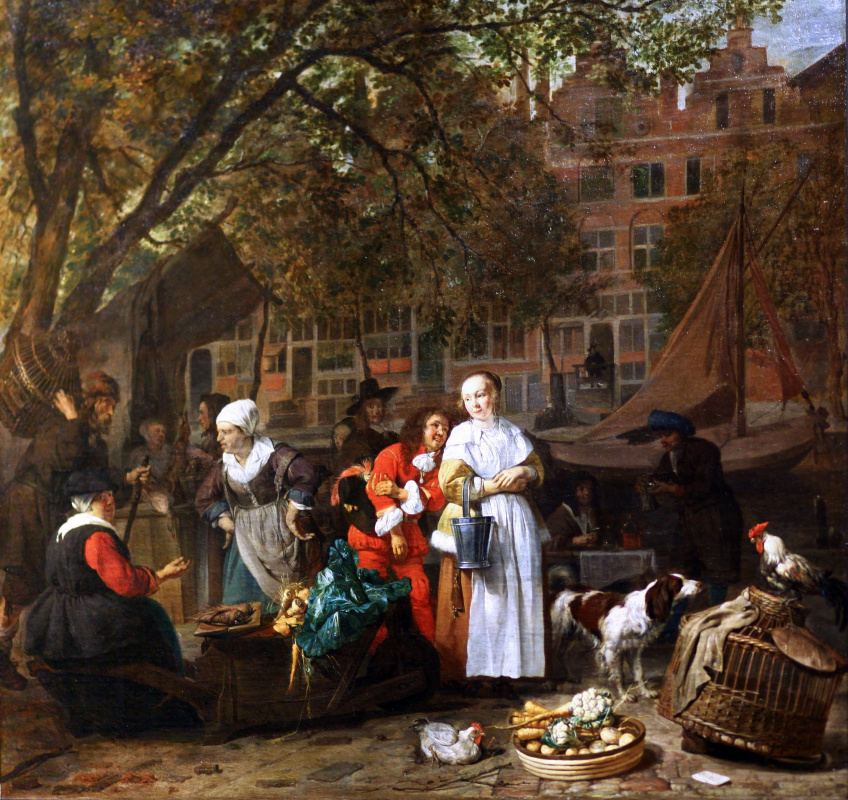log in
Enter site
Login to use Arthive functionality to the maximum
Vegetable market in Amsterdam
Gabriël Metsu • Painting, 1661, 97×84.5 cm
Description of the artwork «Vegetable market in Amsterdam»
“The Vegetable Market” was painted in 1660—1661, when Gabriël Metsu, who lived in Amsterdam, was at the height of his career. This vivid scene from everyday life is actually a reference to a popular comic play. This explains the presence of the daring lackey, dressed in red clownish suit. The large size of the canvas and the soft, almost nostalgic rendition of the urban landscape characterize the painting from the Louvre collection as one of Metsu’s masterpieces.
This vegetable market was located near the Prinsengracht canal, where the artist lived from about 1657 (according to other sources, from 1654). Having settled in the house of his distant relative, he could thoroughly study the life of this small world. He created this genre painting under the influence of the theatre of that time. Undoubtedly, the depicted subjects correspond to the characters of the then very popular farce “Het Moortje” (1615) by the Dutch playwright Gerbrand Adriaensz Bredero.
The foreground is brightly lit to emphasize the rich colours — red, green and white, competing with each other in dazzle. This colourful liveliness contrasts with the muted brown background and the tranquil cityscape with its orderly rhythm and façade geometry.
The composition of this outdoor genre scene is quite interesting. On the left side of the painting, there is a grumpy woman handing firmly on her hips, bargaining hotly for vegetables. The pleasant plump matron stoically ignores her push, turning her head to the viewer. A humorous reflection of this dialogue is the dog and rooster on the right side of the canvas. The dog and the bird stare at each other, and the unstable position of the wicker basket makes it clear that cheerful chaos is about to reign. In the centre, as if isolated from the noise of the market, a flirting scene unfolds. An ardent dandy in an elegant suit is courting a lovely housewife, who listens to him warily, although with interest.
The bright colours of the main subjects in the foreground and the almost monochrome subjects in the background are reminiscent of the artist’s Leyden period, although the painting dates to 1660—1661. This is an exceptional work in the Metsu’s oeuvre, it combines the realism of market life with a reference to the theatre scene. This is a masterpiece in which the painter fully revealed his artistic talent and demonstrated the importance of genre painting.
Author: Vlad Maslov
This vegetable market was located near the Prinsengracht canal, where the artist lived from about 1657 (according to other sources, from 1654). Having settled in the house of his distant relative, he could thoroughly study the life of this small world. He created this genre painting under the influence of the theatre of that time. Undoubtedly, the depicted subjects correspond to the characters of the then very popular farce “Het Moortje” (1615) by the Dutch playwright Gerbrand Adriaensz Bredero.
The foreground is brightly lit to emphasize the rich colours — red, green and white, competing with each other in dazzle. This colourful liveliness contrasts with the muted brown background and the tranquil cityscape with its orderly rhythm and façade geometry.
The composition of this outdoor genre scene is quite interesting. On the left side of the painting, there is a grumpy woman handing firmly on her hips, bargaining hotly for vegetables. The pleasant plump matron stoically ignores her push, turning her head to the viewer. A humorous reflection of this dialogue is the dog and rooster on the right side of the canvas. The dog and the bird stare at each other, and the unstable position of the wicker basket makes it clear that cheerful chaos is about to reign. In the centre, as if isolated from the noise of the market, a flirting scene unfolds. An ardent dandy in an elegant suit is courting a lovely housewife, who listens to him warily, although with interest.
The bright colours of the main subjects in the foreground and the almost monochrome subjects in the background are reminiscent of the artist’s Leyden period, although the painting dates to 1660—1661. This is an exceptional work in the Metsu’s oeuvre, it combines the realism of market life with a reference to the theatre scene. This is a masterpiece in which the painter fully revealed his artistic talent and demonstrated the importance of genre painting.
Author: Vlad Maslov



